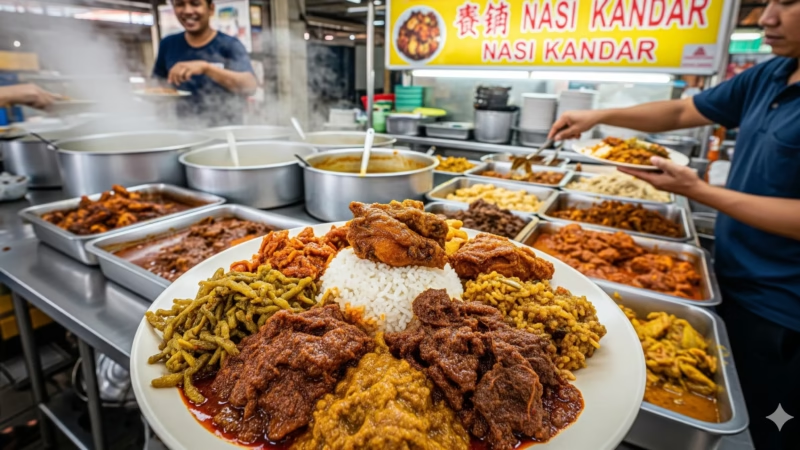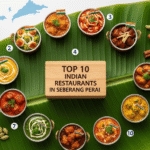Nasi Kandar

What is Nasi Kandar?
Nasi Kandar: Malaysia’s Iconic Curry Rice Dish. Nasi Kandar is a traditional northern Malaysian dish that features a mound of rice topped with an assortment of curries, gravies, and meats.
Nasi Kandar Origin
Nasi Kandar originated in Penang, Malaysia, created by Tamil Muslim immigrants in the early 20th century. Vendors carried rice and a variety of curries on shoulder poles called “kandar,” giving the dish its name.
Nasi Kandar Category
Main course, street food, Malaysian Indian Muslim cuisine.
Appearance
A plate of fluffy white rice served with multiple types of curries and side dishes. Curries are often poured over the rice, creating a colorful, rich presentation with fried shallots, cucumber slices, or boiled eggs as garnish.
Ingredients
For Rice:
- Steamed white rice (optional: ghee or butter)
For Curries:
- Chicken, beef, fish, or squid
- Coconut milk
- Onions, garlic, ginger
- Turmeric, chili, cumin, coriander, fennel
- Salt and sugar
Side Dishes (Optional):
- Fried chicken, boiled eggs, okra, vegetables, pickles
Preparation
- Cook the rice: Steam until fluffy, optionally mixing in ghee for aroma.
- Prepare curries: Slow-cook meat or seafood with spices and coconut milk until tender.
- Assemble the plate: Layer rice with curries and side dishes. Pour gravy over rice for “kuah campur” effect.
Equipment
- Rice cooker or steamer
- Saucepan or wok for curry
- Ladle and serving spoons
- Plates or banana leaves for traditional serving
Variations
- Nasi Kandar Ayam: Chicken-focused
- Nasi Kandar Daging: Beef-focused
- Vegetarian Nasi Kandar: Tofu, tempeh, and vegetables
- Regional Spice Variations: Penang, Kuala Lumpur, Kedah styles differ in spice intensity
Taste
Nasi Kandar offers a rich and flavorful experience from its blend of complex, mixed gravies and curries poured over plain white rice, creating a harmonious mix of spicy and savory notes. Savory, rich, and slightly spicy. The combination of multiple gravies creates a complex, layered flavor.
Texture
Fluffy rice, tender meats, creamy curry, crunchy fried sides, and soft vegetables create a multi-textural experience.
Aroma
Fragrant with curry spices, garlic, onions, coconut milk, and occasional ghee.
Sound
Sizzling from fried items and the ladle pouring curry over rice evoke the vibrant atmosphere of Malaysian street food.
Cultural Significance
Represents the fusion of Indian Muslim culinary traditions with Malaysian flavors. A staple of Penang street food and communal dining culture.
Symbolism
Serving a plate of Nasi Kandar with multiple curries embodies generosity through abundant portions, hospitality in sharing this diverse meal, and a reflection of Malaysia’s rich multicultural food heritage, where Tamil Muslim, Malay, and Indian influences converge.
Regional Cuisine
- Penang is the birthplace, with famous eateries like Line Clear and Deen Maju.
- Popular in Kedah, Perlis, Kuala Lumpur, and other urban areas.
Social Context
Eaten daily by locals as lunch or dinner. Traditionally served at roadside stalls (“mamak shops”), fostering communal dining and social interaction.
Nutritional Information
- High in carbohydrates (rice)
- Moderate protein (meat, seafood)
- Moderate fats from coconut milk and fried items
- Caloric content varies with portion size and number of curries
Health Benefits
- Provides protein and essential minerals
- Spices like turmeric and cumin have anti-inflammatory properties
- Coconut milk contains healthy fats
Dietary Restrictions
- Not suitable for strict vegetarians or vegans unless customized
- Can be high in sodium and fat if heavy gravies and fried items are included
Allergens
- Dairy (ghee or butter)
- Seafood (fish, squid)
- Nuts (occasionally in gravies or garnishes)
Cost
Affordable street food: approximately MYR 8–20 per plate, depending on sides and curry choices.
Production
Made fresh daily at stalls or restaurants. Curries are slow-cooked to intensify flavor and aroma.
Sustainability
- Dependent on sourcing of meat and seafood
- Traditional banana leaf serving reduces plastic use
- Locally sourced ingredients preferred for sustainability
Availability
Widely available in Penang, urban Malaysian areas, and Indian Muslim eateries globally.
History
- Early 1900s: Tamil Muslim vendors sold rice and curry to laborers.
- Evolved into a signature Malaysian dish with multiple curries per plate.
Anecdotes
- Mixing curries on one plate is known as “kuah campur,” giving Nasi Kandar its signature flavor.
- Famous Penang stalls are considered culinary pilgrimage sites for locals and tourists alike.
How to Prepare Nasi Kandar (Simplified Home Version)
Step 1: Cook Rice
- Steam white rice until fluffy; stir in ghee if desired.
Step 2: Make Curries
- Sauté onions, garlic, ginger, and spices.
- Add coconut milk and protein of choice (chicken, beef, or fish).
- Simmer until meat is tender and sauce thickens.
Step 3: Assemble
- Place rice on a plate, layer with multiple curries.
- Add side dishes like fried chicken, boiled eggs, okra, or pickles.
- Garnish with fried shallots and cucumber slices.
Step 4: Serve
- Serve hot. Encourage mixing of gravies for authentic “kuah campur” taste.
Top 10 Nasi Kandar Spots in Kuala Lumpur…
Discover the top 10 nasi kandar spots in Kuala…
Top 10 Nasi Kandar Spots in Seberang Perai
Discover the 10 best nasi kandar spots in Seberang…
Top 10 Nasi Kandar Spots in Kuching
Discover the Top 10 Nasi Kandar spots in Kuching!…
Top 10 Indian Restaurants in Seberang Perai
Discover the top 10 Indian restaurants in Seberang Perai…
Pelita Nasi Kandar Chai Leng Park – Butterworth’s…
Discover the original Pelita Nasi Kandar in Chai Leng…
Bandar Seri Iskandar
Discover Bandar Seri Iskandar, Perak – a growing town…
FAQ: Nasi Kandar
Q: Can I make Nasi Kandar vegetarian?
A: Yes, use tofu, tempeh, mushrooms, and vegetables with vegetable-based curry.
Q: What makes Nasi Kandar different from regular curry rice?
A: The signature is multiple curries poured over one plate, creating a mix of flavors called “kuah campur.”
Q: Is it spicy?
A: It can range from mild to very spicy depending on the curry and region.
Q: Where can I try authentic Nasi Kandar?
A: Famous Penang stalls: Line Clear, Deen Maju, and Nasi Kandar Beratur.
Q: Can it be stored?
A: Rice and curry can be refrigerated, but best eaten fresh to enjoy flavors fully.



















Comments are closed.